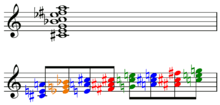Complexe sonore

Complexe sonore: the octatonic scale may be arranged as four major chords or seventh chords[1]  Play .
Play .

Octatonic scale on E (bottom), and symmetrical rotations by minor third (t3) of the Dorian mode on E, G, B♭, and D♭, (top three) from that scale.[2]
The complexe sonore is an octatonic chord consisting of minor third relations.[1]
More precisely, the complexe sonore is Igor Stravinsky's use of diatonic and whole tone motifs, and scales, against an octatonic background, rotated by minor thirds. Stravinsky, "considered them to be in a perpetual state of potential symmetrical rotation by minor thirds (hereafter represented by the figures /0 3 6 9/) under which the octatonic background scale is invariant."[3]
See also
References
- 1 2 Taruskin, Richard (1996). Stravinsky and the Russian Traditions: A Biography of the Works through Mavra, p.937 and 1394. ISBN 0-520-07099-2.
- ↑ Taruskin (2000), p.439.
- ↑ Taruskin, Richard (2000). Defining Russia Musically: Historical and Hermeneutical Essays, p.438. ISBN 978-0-691-07065-0.
This article is issued from Wikipedia - version of the 10/28/2013. The text is available under the Creative Commons Attribution/Share Alike but additional terms may apply for the media files.